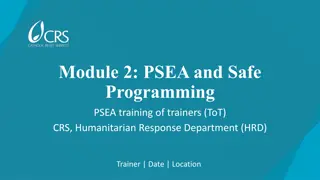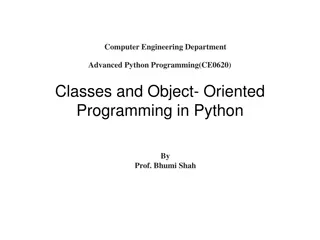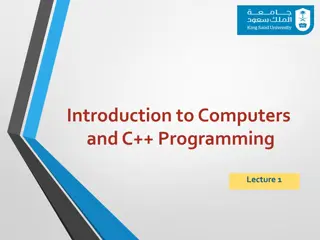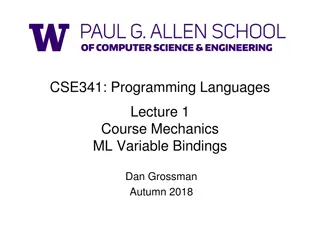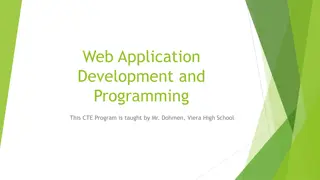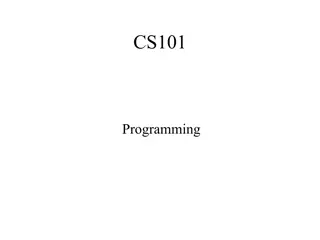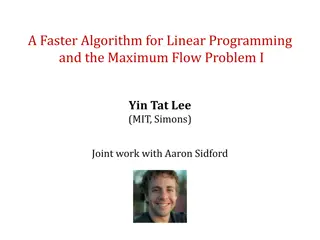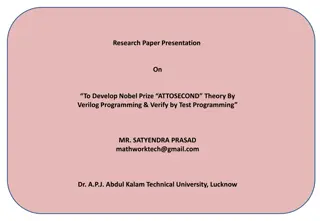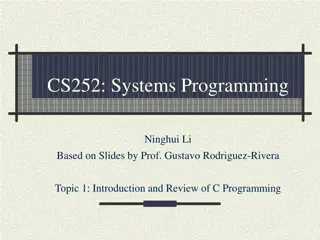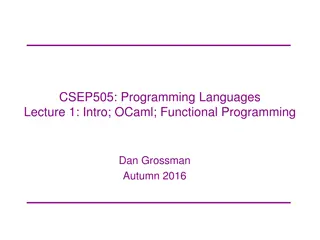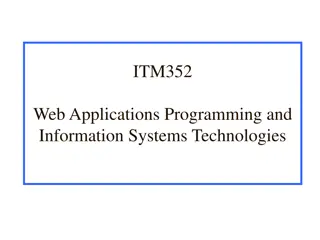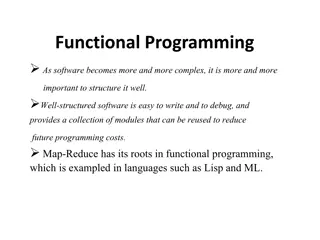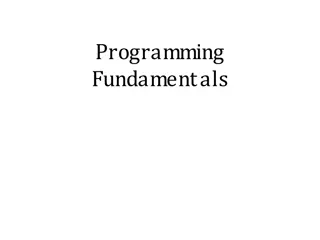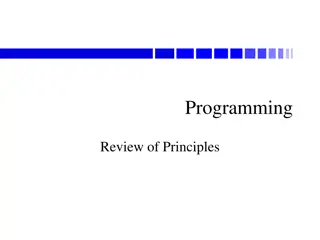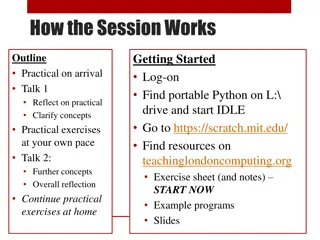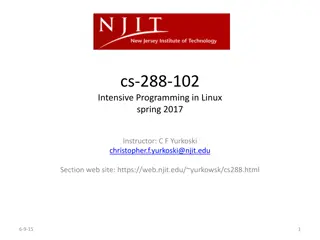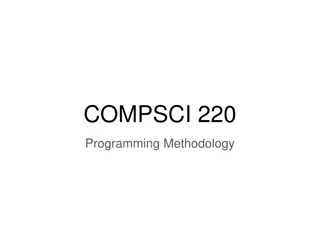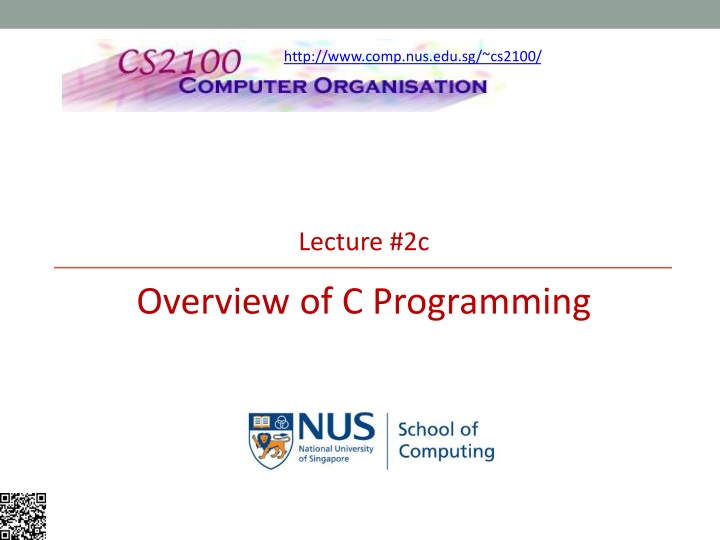
Overview of C Programming Selection Structures and Operators
Learn about selection structures in C programming including if-else statements, condition and relational operators, truth values, and more. Explore how these elements work to control the flow of your C programs effectively.
Download Presentation

Please find below an Image/Link to download the presentation.
The content on the website is provided AS IS for your information and personal use only. It may not be sold, licensed, or shared on other websites without obtaining consent from the author. If you encounter any issues during the download, it is possible that the publisher has removed the file from their server.
You are allowed to download the files provided on this website for personal or commercial use, subject to the condition that they are used lawfully. All files are the property of their respective owners.
The content on the website is provided AS IS for your information and personal use only. It may not be sold, licensed, or shared on other websites without obtaining consent from the author.
E N D
Presentation Transcript
http://www.comp.nus.edu.sg/~cs2100/ Lecture #2c Overview of C Programming
Questions? IMPORTANT: DO NOT SCAN THE QR CODE IN THE VIDEO RECORDINGS. THEY NO LONGER WORK Ask at https://sets.netlify.app/module/676ca3a07d7f5ffc1741dc65 OR Scan and ask your questions here! (May be obscured in some slides)
Lecture #2: Overview of C Programming 3 6. Selection Structures (1/2) C provides two control structures that allow you to select a group of statements to be executed or skipped when certain conditions are met. if else if(condition) { /* Execute these statements if TRUE */ } ifcondition: # Statement ifcondition: # Statement elifcondition: # Statement else: # Statement if (condition) { /* Execute these statements if TRUE */ } else { /* Execute these statements if FALSE */ }
Lecture #2: Overview of C Programming 4 6. Selection Structures (2/2) Python switch No counterpart /* variable or expression must be of discrete type */ switch ( <variable or expression> ) { case value1: Code to execute if <variable or expr> == value1 break; case value2: Code to execute if <variable or expr> == value2 break; ... } default: Code to execute if <variable or expr> does not equal to the value of any of the cases above break;
Lecture #2: Overview of C Programming 5 6.1 Condition and Relational Operators A condition is an expression evaluated to true or false. It is composed of expressions combined with relational operators. Examples: (a <= 10), (count > max), (value != -9) Relational Operator < <= > >= == != Interpretation is less than is less than or equal to is greater than is greater than or equal to is equal to is not equal to Python Allows 1 <= x <= 5
Lecture #2: Overview of C Programming 6 6.2 Truth Values Boolean values: true or false. There is no Boolean type in ANSI C. Instead, we use integers: 0 to represent false Any other value to represent true (1 is used as the representative value for true in output) Example: Python NOTE: only integers! In Python and JavaScript you have truthy and falsy values, but not in C TruthValues.c int a = (2 > 3); int b = (3 > 2); a = 0; b = 1 printf("a = %d; b = %d\n", a, b);
Lecture #2: Overview of C Programming 7 6.3 Logical Operators Complex condition: combining two or more Boolean expressions. Examples: If temperature is greater than 40C or blood pressure is greater than 200, go to A&E immediately. If all the three subject scores (English, Maths and Science) are greater than 85 and mother tongue score is at least 80, recommend taking Higher Mother Tongue. Logical operators are needed: && (and), || (or), ! (not). A B A && B False False False True A || B False True True True !A True True False False Python False False True True False True False True A || B A or B A && B A and B !A not A
Lecture #2: Overview of C Programming 8 6.4 Evaluation of Boolean Expressions (1/2) The evaluation of a Boolean expression is done according to the precedence and associativity of the operators. Operator Type Operator Associativity ( ) [ ] . -> expr++ expr-- Primary expression operators Unary operators Binary operators Left to Right * & + - ! ~ ++expr --expr (typecast) sizeof Right to Left Left to Right * / % + - < > <= >= Python == != cond ? expr1 : expr2 expr1 if cond else cond2 && || ?: Ternary operator Assignment operators Right to Left Right to Left = += -= *= /= %=
Lecture #2: Overview of C Programming 9 6.4 Evaluation of Boolean Expressions (2/2) What is the value of x? x is true (1) int x, y, z, a = 4, b = -2, c = 0; x = (a > b || b > c && a == b); gcc issues warning (why?) Always good to add parentheses for readability. y is false (0) y = ((a > b || b > c) && a == b); What is the value of z? z is true (1) z = ((a > b) && !(b > c)); Try out EvalBoolean.c
Lecture #2: Overview of C Programming 10 6.5 Short-Circuit Evaluation Does the following code give an error if variable a is zero? if ((a != 0) && (b/a > 3)) { printf(. . .); } Short-circuit evaluation expr1 || expr2: If expr1 is true, skip evaluating expr2 and return true immediately, as the result will always be true. expr1 && expr2: If expr1 is false, skip evaluating expr2 and return false immediately, as the result will always be false.
Lecture #2: Overview of C Programming 11 7. Repetition Structures (1/2) C provides three control structures that allow you to select a group of statements to be executed repeatedly. while ( condition ) { // loop body } do { // loop body } while ( condition ); for ( initialization; condition; update ) { // loop body } Update: change value of loop variable Initialization: initialize the loop variable Condition: repeat loop while the condition on loop variable is true
Lecture #2: Overview of C Programming 12 7. Repetition Structures (2/2) Example: Summing from 1 through 10. Sum1To10_DoWhile.py int sum = 0, i = 1; do { sum = sum + i; i++; } Sum1To10_DoWhile.c Sum1To10_While.py Sum1To10_While.c sum, i = 0, 1 sum = sum + i i = i + 1 while i <= 10: sum = sum + i i = i + 1 while (i <= 10); sum,i = 0, 1 while i <= 10: sum = sum + i i = i + 1 i++; } int sum = 0, i = 1; while (i <= 10) { sum = sum + i; Sum1To10_For.py Sum1To10_For.c sum = 0 for i in range(1, 11): sum = sum + i sum = sum + i; } int sum, i; for (sum = 0, i = 1; i <= 10; i++) {
Lecture #2: Overview of C Programming 13 7.1 Using break in a loop (1/2) BreakInLoop.py BreakInLoop.c Without 'break': 1 Ya 2 Ya 3 Ya 4 Ya 5 Ya # without 'break' print("Without 'break':"); for i in range(1,6): print(i) print("Ya") printf("Ya\n"); } // without 'break' printf ("Without 'break':\n"); for (i=1; i<=5; i++) { printf("%d\n", i); # with 'break' print("With 'break':"); for i in range(1,6): print(i) if i == 3: break print("Ya") } } // with 'break' printf ("With 'break':\n"); for (i=1; i<=5; i++) { printf("%d\n", i); if (i==3) break; printf("Ya\n"); With 'break': 1 Ya 2 Ya 3
Lecture #2: Overview of C Programming 14 7.1 Using break in a loop (2/2) With 'break in 1, 1 Ya 1, 2 Ya 1, 3 2, 1 Ya 2, 2 Ya 2, 3 3, 1 Ya 3, 2 Ya 3, 3 BreakInLoop.py BreakInLoop.c # with 'break' in a nested loop print("With 'break' in a nested loop:") for i in range(1,4): for j in range(1,6): print(i, ",", j) if j == 3: break; print("Ya") } } // with 'break' in a nested loop printf("With 'break' in a nested loop:\n"); for (i=1; i<=3; i++) { for (j=1; j<=5; j++) { printf("%d, %d\n", i, j); if (j==3) break; printf("Ya\n"); In a nested loop, break only breaks out of the inner-most loop that contains the break statement.
Lecture #2: Overview of C Programming 15 7.2 Using continue in a loop (1/2) Without 'continue': 1 Ya 2 Ya 3 Ya 4 Ya 5 Ya ContinueInLoop.py ContinueInLoop.c # without 'continue' print("Without 'continue':") for i in range(1,6): print(i) print("Ya") printf("Ya\n"); } // without 'continue' printf ("Without 'continue':\n"); for (i=1; i<=5; i++) { printf("%d\n", i); # with 'continue' print("With 'continue':") for i in range(1,6): print(i) if i == 3: continue print("Ya") printf("Ya\n"); } // with 'continue' printf ("With 'continue':\n"); for (i=1; i<=5; i++) { printf("%d\n", i); if (i==3) continue; With 'continue': 1 Ya 2 Ya 3 4 Ya 5 Ya
Lecture #2: Overview of C Programming 16 7.2 Using continue in a loop (2/2) With ... 1, 1 Ya 1, 2 Ya 1, 3 1, 4 Ya 1, 5 Ya 2, 1 Ya 2, 2 Ya 2, 3 2, 4 Ya 2, 5 Ya ContinueInLoop.py ContinueInLoop.c # with 'continue' in a nested loop print("With 'continue' in a nested loop:") for i in range(1,4): for j in range(1,6): print(i, ",", j) if j == 3: continue print("Ya") } } // with 'continue' in a nested loop printf("With 'continue' in a nested loop:\n"); for (i=1; i<=3; i++) { for (j=1; j<=5; j++) { printf("%d, %d\n", i, j); if (j==3) continue; printf("Ya\n"); 3, 1 Ya 3, 2 Ya 3, 3 3, 4 Ya 3, 5 Ya In a nested loop, continue only skips to the next iteration of the inner-most loop that contains the continue statement.
Lecture #2: Overview of C Programming 1 - 17 Quiz Please complete the CS2100 C Programming Quiz 2 in Canvas. Access via the Quizzes tool in the left toolbar and select the quiz on the right side of the screen.
Lecture #2: Overview of C Programming 18 End of File




